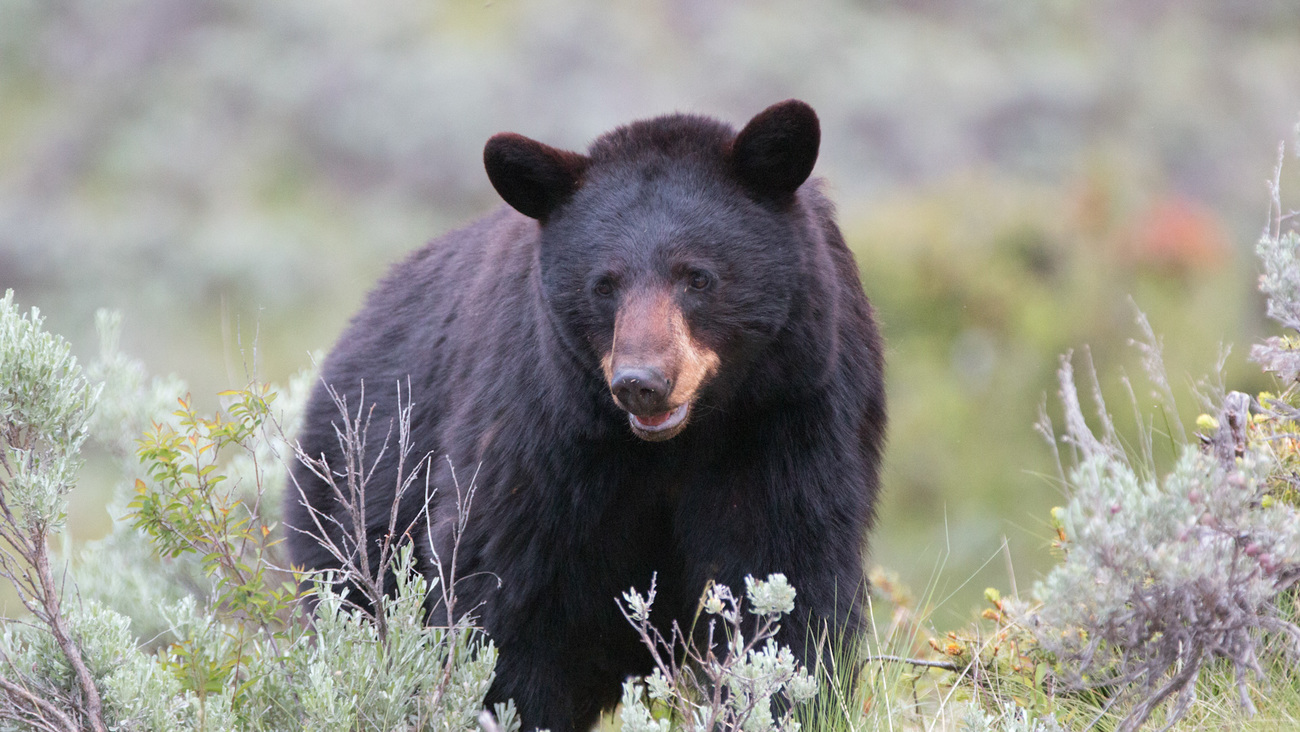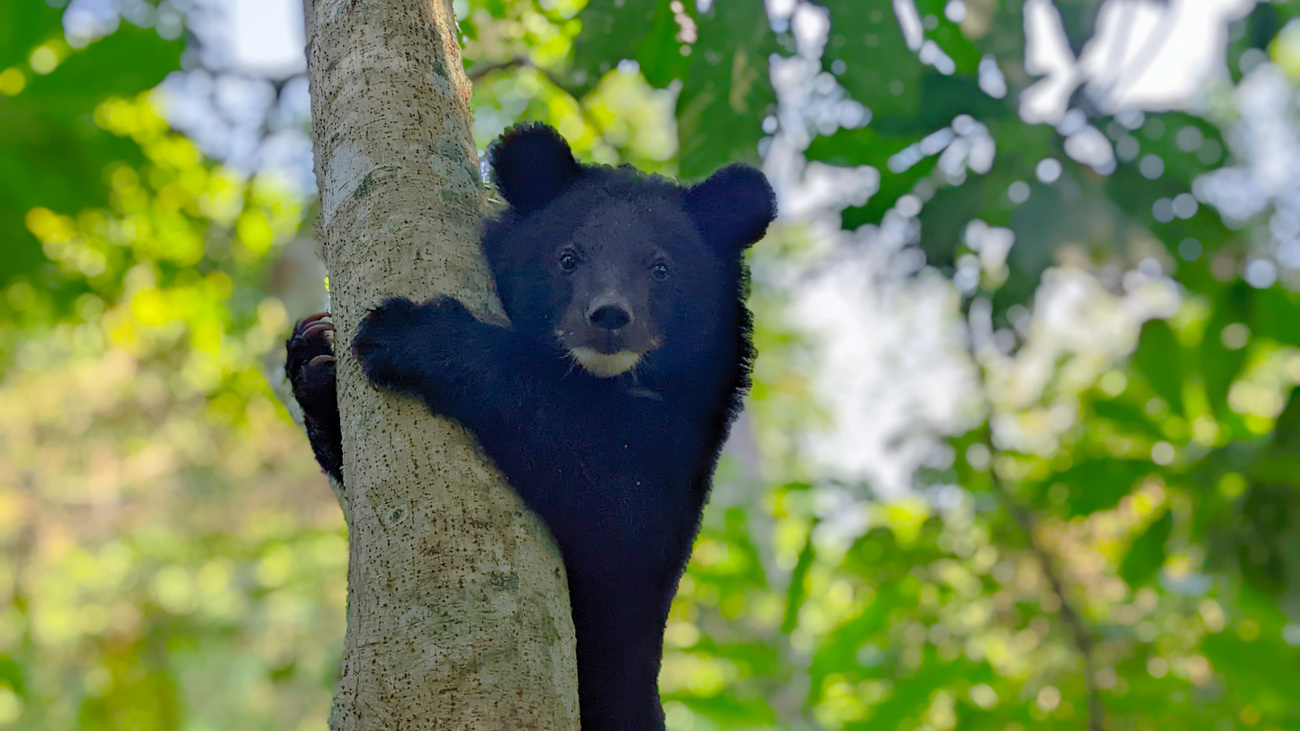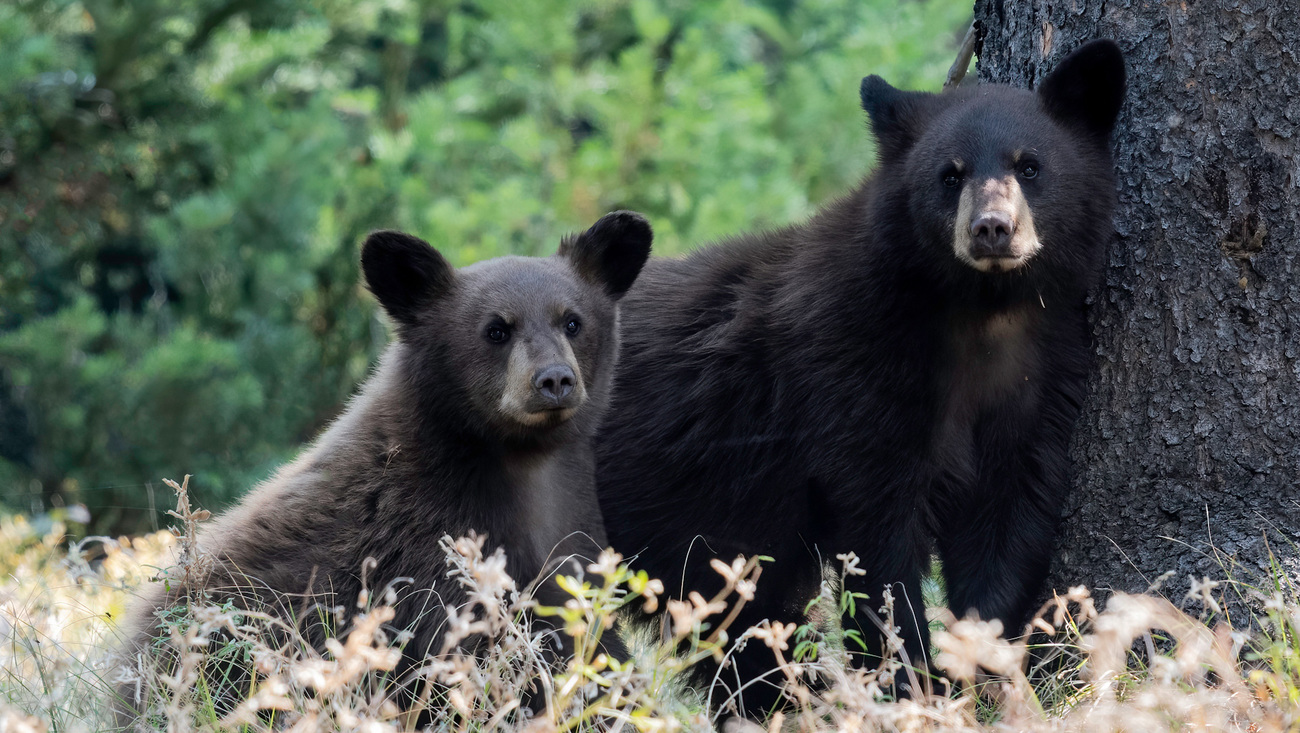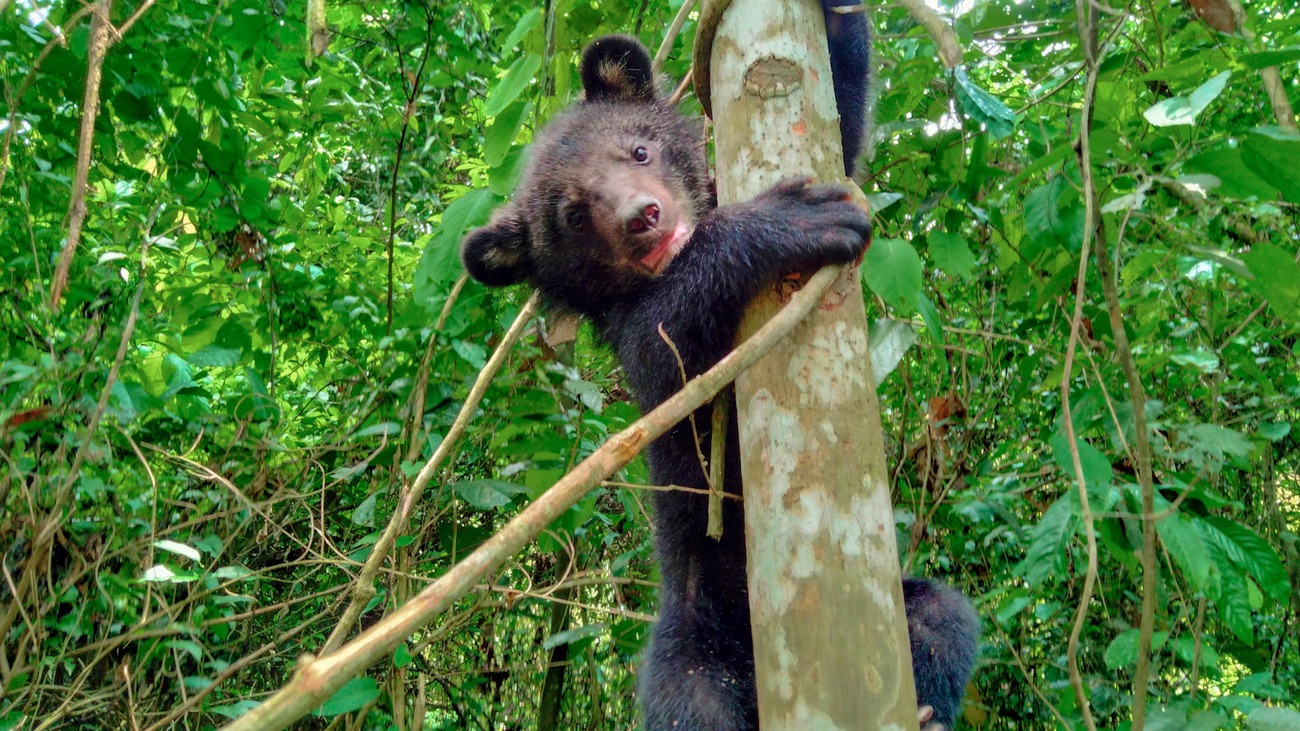Black bears
American black bears are large mammals found in North America. They have a distinctive appearance, with thick, dark fur, a prominent snout, and round ears. Smaller than brown bears, adults typically range from 1.3 to 1.9 meters (4.3 to 6.2 feet) in length and weigh between 60 and 300 kilograms (132 and 661 pounds). However, the largest male black bears can grow up to 2 meters long (6.6 feet) and weigh as much as 400 kilograms (or 900 pounds).
Black bears are omnivores and eat a varied diet that includes berries, nuts, insects, small mammals, fish, and plants. This adaptable diet makes them essential to their ecosystems—they help control plant populations and disperse seeds, which is crucial for forest regeneration.
Though black bears are typically solitary and prefer to live alone, males and females do come together to mate in late spring and early summer. A mother will then give birth to a litter of one to three cubs during the winter after seven months of gestation. Black bear cubs are born blind and toothless but fully furred, and they remain with their mother for 16 months before becoming independent.
Protecting black bears and their habitats is crucial for maintaining healthy ecosystems. They distribute seeds over vast distances; aid in the decomposition of trees, which returns nutrients to the soil; and open up forest canopies, allowing sunlight to filter through and promote biodiversity.
What is a black bear’s scientific name?
The scientific name for an American black bear is Ursus americanus, which translates to ‘American bear’.
Are black bears endangered?
Black bears are listed as ‘least concern’ on the IUCN Red List of Threatened Species, and their population is currently on the rise.
However, they do still face a range of threats, including habitat loss and trophy hunting. Considering the crucial role that black bears play in maintaining healthy ecosystems, we must continue to ensure they live happily and healthily in the wild.
Where do black bears live?
Black bears can be found in a variety of habitats across North America from Canada to Mexico. They predominantly live in forests, where they can find ample food, water, shelter, and protection. Black bears tend to thrive in rugged, high-elevation terrain, like mountain ranges.
Threats
Black bears face many threats, all of which stem from human actions. From habitat loss to trophy hunting, black bears need to be protected from an array of man-made challenges to ensure their survival. Black bears are also threatened by residential, commercial, and agricultural development, as well as human transport and traffic flow.

Residential & commercial development
As human populations grow and urban areas expand, black bears often lose their natural habitats to residential and commercial development. Such urbanization not only leaves bears with no safe place to live but can also increase human-bear conflicts.
Agricultural development
Across North America, the black bear’s natural habitat is being claimed for agricultural purposes. These encroachments increase human-bear contact, making black bears more likely to raid crops and beehives. This causes conflicts with farmers, who are sometimes forced to hunt and kill black bears to protect their property and livelihoods.
Human transport & traffic flow
As more and more railways and roads are built and expanded and the volume of traffic flow increases, human transport services encroach on the black bear’s habitat. This also leads to vehicle collisions, a significant cause of black bear mortality.
When a stretch of highway in North Carolina was upgraded from two lanes to four last decade, there was a noticeable increase in the number of human-caused black bear deaths in the area, even the upgrades included building underpasses.
Trophy hunting
Black bears are legally classified as game animals and can be hunted, though the practice is heavily regulated and managed on a state-by-state basis, with hunters needing proper documentation to legally kill the animals. However, illegal hunting does still exist. It’s estimated that around 40,000-50,000 bears are hunted for their fur, body parts, and trophies each year in North America.
There needs to be increased cooperation among agencies and more strict hunting regulations put in place to protect the American black bear population.
FAQs
What do black bears eat?
Technically, black bears are classed as carnivores—meat eaters—but they are actually omnivores. Bears are opportunistic feeders, meaning they can find sustenance in a large range of places, depending on what’s easily accessible around them. They are also excellent climbers and swimmers, allowing them to reach diverse food sources.
A black bear’s diet consists primarily of grass, roots, berries, and insects, which can be foraged from trees and the forest floor. They also eat fish and mammals on occasion.
As opportunistic eaters, black bears also can easily develop a taste for garbage and human food. If bears become accustomed to finding and eating food from campsites, cabins, or rural homes, they are likely to be maimed or killed by humans who fear for their safety.
Do black bears eat meat?
Black bears do eat meat, including fish, caribou, deer, elk, moose, and a wide variety of insects, but it only makes up 10% of their diet. The rest of their diet is plant-based.
In the warmer months, when they’re not hibernating, black bears spend almost all their time hunting, foraging, and eating. To build up fat stores for winter, black bears tend to favor food that is high in fat, protein, and sugar.

How fast can a black bear run?
Despite their large size and bulky appearance, black bears can run at speeds of 40 to 50 kilometers per hour (25 to 30 miles per hour) for short bursts. They cannot maintain this speed for long, though, particularly when they have their thick winter coats.
How much does a black bear weigh?
On average, adult black bears weigh anywhere from 60 to 300 kilograms (132 to 661 pounds). The largest males can weigh up to 409 kilograms (902 pounds), as males can be up to 70% heavier than females.
How tall is a black bear?
Adult black bears are around 1.3 to 1.9 meters (4.3 to 6.2 feet) long, though some males can grow to be a lot larger than average, reaching up to 2 meters (6.6 feet).
Can black bears climb trees?
Black bears can climb trees. Their short claws help them cling to trunks and ascend quickly. Branches are also handy places for younger or smaller black bears to hide out of reach of predators.
Black bear cubs are often playful and adventurous and enjoy scaling trees for fun.
Do black bears hibernate?
Black bears hibernate through the winter, typically for six months from mid-November to mid-March. They spend the winter months curled up in dens to avoid the cold and lack of abundant food sources.
During this winter denning time, black bears enter a state of reduced metabolic activity where they become less active, but they are not in a deep, continuous hibernation like grizzlies or polar bears. They can rouse themselves if disturbed and may even leave the den briefly during milder winter spells to forage for food.
The hibernation patterns of black bears also depend on where on the continent they are located. Bears in Alaska will hibernate for seven months, while those further south on the US West Coast, where the climate is warmer, may only hibernate for two months.
During the winter denning period, pregnant female bears give birth to their cubs. Bears without cubs emerge in the early spring, while mother bears and their cubs emerge later, around the end of March.

How long do black bears live?
The typical lifespan of a black bear is 20 years. This can vary based on factors including habitat quality, food availability, and human-related threats. In captivity, black bears have been known to live even longer, often exceeding 30 years.
Conservation efforts, including habitat protection and responsible management, are crucial in promoting healthy black bear populations and ensuring their long-term survival in the wild.
Are black bears dangerous?
Black bears can be dangerous to humans in certain situations. By nature, they are generally shy and non-aggressive animals and try to avoid interactions with people. However, if they feel threatened or cornered, they can present a danger to humans.
Since 1900, only 61 people have been killed by black bears across all of North America. Most attacks by black bears are defensive reactions to people who get too close, and injuries from these interactions are typically minor.
What do you do if you see a black bear?
Many people travel to national parks with the hope of seeing a black bear. However, we must take proper precautions to keep both ourselves and the bears safe.
- Check-in at visitor centers to get up-to-date information on bear sightings.
- If you see a bear, never surprise or sneak up on it. Observe it from a safe distance; most bears will avoid humans if they hear them coming.
- Make a special effort to be noticeable while hiking by walking loudly, talking, or attaching a bell to your backpack.
- If a bear spots you, make it clear that you are a human. Stand your ground and slowly wave your arms.
- Don’t run, make any sudden movements, or scream. Telling the bear to back off will help it recognize you as a human, but screams may confuse it into thinking you’re a prey animal.
- Wait until the bear moves, or slowly walk away in the opposite direction.
Our work
IFAW advocates for stronger regulations that protect wildlife corridors and promote habitat connectivity in the US. Highway crossings for wildlife help protect black bears and other animals from vehicle collisions and allow species to migrate safely. Recently, we supported landmark legislation in the US House of Representatives to safeguard biodiversity, mitigate climate impacts, and reduce highway fatalities.
We’re also focused on the protection of bear species outside North America. In 2003, we established a center in India with the Arunachal Pradesh Forest Department and the Wildlife Trust of India that rehabilitates orphaned bear cubs and helps transition them back into the wild. In early 2022, we committed to help fund the rescue of two bears kept in small concrete cages at the Phuket Zoo, moving them to a large sanctuary. The two bears—Pookie and Ginny—now live in bigger enclosures that include hammocks, a bath, platforms, grass, and other forms of enrichment.
We’re also currently working on a large-scale project to protect animals and people during the war in Ukraine. Part of this effort includes supporting an emergency appeal for Ukrainian Zoos organized by the European Association of Zoos and Aquaria (EAZA). The largest contribution for that fund was made by IFAW, and thanks to our grant funding, the most urgent needs of 26 zoos in Ukraine were met.

How can you help?
All our conservation projects around the world could not happen without the support of animal lovers like you. Donations help us continue our important, life-saving work of rescue and conservation around the world.